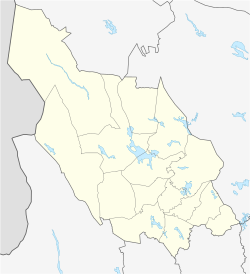world.wikisort.org - Sweden
Älvdalen (Elfdalian: Övdaln or Tjyörtjbynn; literally meaning The River Valley) is a locality and the seat of Älvdalen Municipality in Dalarna County, Sweden, with 1,810 inhabitants in 2010.[1]
Älvdalen | |
|---|---|
 Älvdalen  Älvdalen | |
| Coordinates: 61°14′N 14°02′E | |
| Country | Sweden |
| Province | Dalarna |
| County | Dalarna County |
| Municipality | Älvdalen Municipality |
| Area | |
| • Total | 3.02 km2 (1.17 sq mi) |
| Population (31 December 2010)[1] | |
| • Total | 1,810 |
| • Density | 600/km2 (2,000/sq mi) |
| Time zone | UTC+1 (CET) |
| • Summer (DST) | UTC+2 (CEST) |
| Climate | Dfc |
The parish is widely known for being the place of manufacturing, in 1839, of the 4-meter granite vase (called Älvdalen Vase), installed in the Summer Garden in Saint Petersburg (a gift from Charles XIV John of Sweden to Nicholas I of Russia).
Nearby is the Hykjebergets Nature Reserve, inaugurated by Prince Carl Philip and Princess Sofia in 2016.[2]
It is also known for its language called Elfdalian, which along with innovations[3] also preserves some Old Norse traits not preserved in most (other) North Germanic languages.[4][5]
Climate
Älvdalen has a subarctic climate influenced by its location near the furthest interior position on the Scandinavian Peninsula. As a result, seasonal swings are large and the general climate has strong resemblances to Skellefteå much further north at sea level. Being in a river valley, the area is also prone to temperature inversion and harsh freezing. Compared to Mora about 35 kilometres (22 mi) to its southeast, temperature differences are comparatively large since Mora is lower, further south and situated by the slightly moderating lake of Siljan.
| Climate data for Älvdalen (2002–2021 averages); extremes since 1968 | |||||||||||||
|---|---|---|---|---|---|---|---|---|---|---|---|---|---|
| Month | Jan | Feb | Mar | Apr | May | Jun | Jul | Aug | Sep | Oct | Nov | Dec | Year |
| Record high °C (°F) | 8.3 (46.9) |
11.2 (52.2) |
16.6 (61.9) |
24.5 (76.1) |
28.2 (82.8) |
33.0 (91.4) |
31.8 (89.2) |
33.9 (93.0) |
26.5 (79.7) |
22.2 (72.0) |
14.5 (58.1) |
10.1 (50.2) |
33.9 (93.0) |
| Mean maximum °C (°F) | 5.0 (41.0) |
6.1 (43.0) |
11.6 (52.9) |
17.5 (63.5) |
23.9 (75.0) |
26.5 (79.7) |
28.0 (82.4) |
25.9 (78.6) |
21.2 (70.2) |
14.9 (58.8) |
9.3 (48.7) |
5.3 (41.5) |
29.2 (84.6) |
| Average high °C (°F) | −3.6 (25.5) |
−1.2 (29.8) |
3.9 (39.0) |
9.8 (49.6) |
15.2 (59.4) |
19.7 (67.5) |
22.1 (71.8) |
19.8 (67.6) |
15.2 (59.4) |
8.0 (46.4) |
1.9 (35.4) |
−2.1 (28.2) |
9.1 (48.3) |
| Daily mean °C (°F) | −7.7 (18.1) |
−5.9 (21.4) |
−1.7 (28.9) |
3.6 (38.5) |
8.9 (48.0) |
13.3 (55.9) |
15.8 (60.4) |
14.0 (57.2) |
9.8 (49.6) |
4.8 (40.6) |
−1.4 (29.5) |
−5.9 (21.4) |
4.0 (39.1) |
| Average low °C (°F) | −11.8 (10.8) |
−10.5 (13.1) |
−7.3 (18.9) |
−2.7 (27.1) |
2.6 (36.7) |
6.8 (44.2) |
9.5 (49.1) |
8.1 (46.6) |
4.4 (39.9) |
−0.3 (31.5) |
−4.7 (23.5) |
−9.7 (14.5) |
−1.3 (29.7) |
| Mean minimum °C (°F) | −24.6 (−12.3) |
−23.3 (−9.9) |
−19.3 (−2.7) |
−9.6 (14.7) |
−4.5 (23.9) |
0.2 (32.4) |
2.8 (37.0) |
0.7 (33.3) |
−2.6 (27.3) |
−9.1 (15.6) |
−15.4 (4.3) |
−21.5 (−6.7) |
−26.8 (−16.2) |
| Record low °C (°F) | −37.3 (−35.1) |
−35.7 (−32.3) |
−32.4 (−26.3) |
−19.9 (−3.8) |
−7.9 (17.8) |
−3.6 (25.5) |
−0.5 (31.1) |
−3.2 (26.2) |
−9.5 (14.9) |
−20.3 (−4.5) |
−27.0 (−16.6) |
−35.7 (−32.3) |
−37.3 (−35.1) |
| Average precipitation mm (inches) | 40.4 (1.59) |
26.8 (1.06) |
23.7 (0.93) |
26.6 (1.05) |
58.5 (2.30) |
68.6 (2.70) |
83.2 (3.28) |
82.9 (3.26) |
50.1 (1.97) |
55.7 (2.19) |
47.6 (1.87) |
37.1 (1.46) |
601.2 (23.66) |
| Source 1: SMHI Open Data[6] | |||||||||||||
| Source 2: SMHI climate data 2002–2021[7] | |||||||||||||
See also
References
- "Tätorternas landareal, folkmängd och invånare per km2 2005 och 2010" (in Swedish). Statistics Sweden. 14 December 2011. Archived from the original on 27 January 2012. Retrieved 10 January 2012.
- "Prince Carl Philip and Princess Sofia show off one of their wedding gifts". Hello Magazine.
- Sapir, Yair: Elfdalian, the Vernacular of Övdaln (essay, 2011)
- last strongholds
- O'Hagan, Sean: Witch hunts, mystics and race cars: inside the weirdest village in Sweden (photo-essay on photographer Maja Daniels's three-year sojourn in Älvdalen and her family connection to Elfdalian)
- "SMHI öppna data för Älvdalen" (in Swedish). Swedish Meteorological and Hydrological Institute.
- "SMHI Monthly & Yearly Statistics 2002–2021" (in Swedish). SMHI. 22 December 2021. Archived from the original on 25 December 2018. Retrieved 22 December 2021.
На других языках
[de] Älvdalen
Älvdalen ist ein Ort in der Provinz Dalarnas län und der historischen Provinz Dalarna in Schweden. Er ist der Hauptort der Gemeinde Älvdalen.- [en] Älvdalen
[ru] Эльвдален
Э́львдален (Э́льфдален; швед. Älvdalen, эльвд. Övdaln, Tjyörtjbynn) — город в Даларне (Швеция).Другой контент может иметь иную лицензию. Перед использованием материалов сайта WikiSort.org внимательно изучите правила лицензирования конкретных элементов наполнения сайта.
WikiSort.org - проект по пересортировке и дополнению контента Википедии